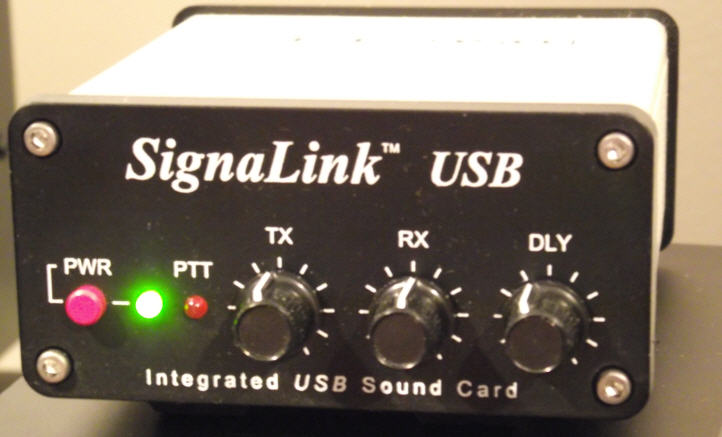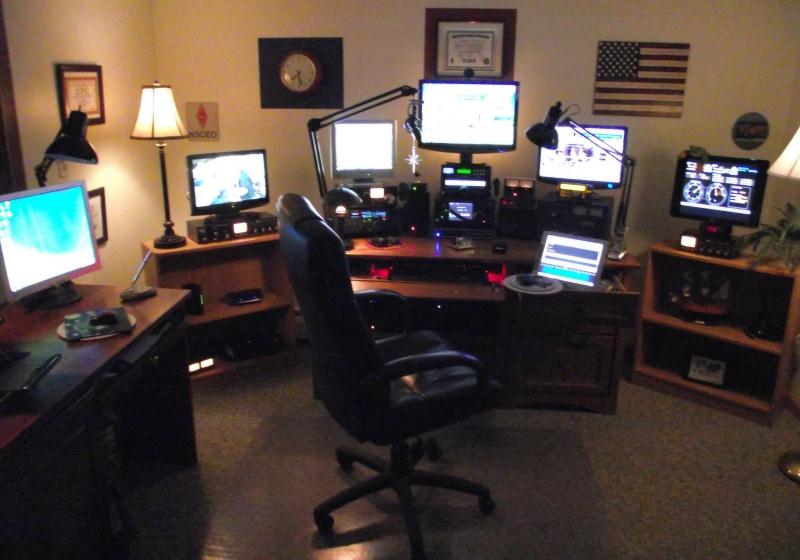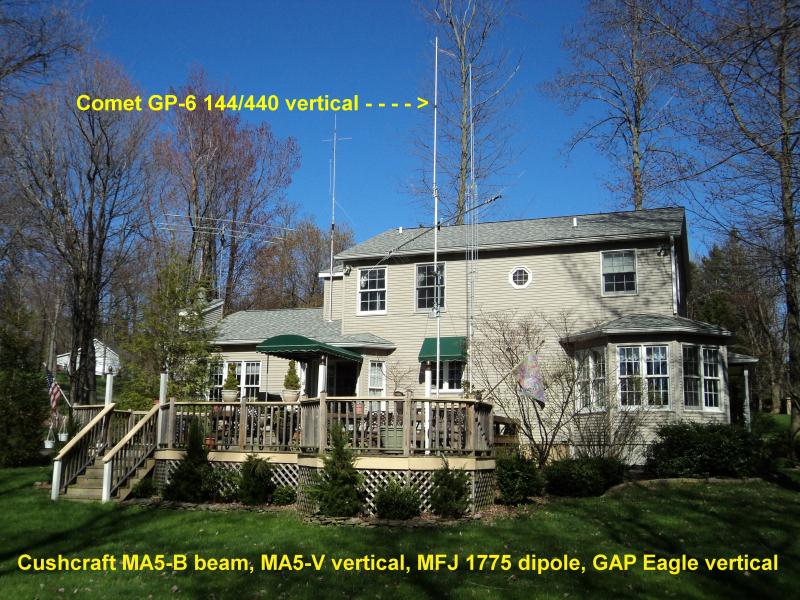


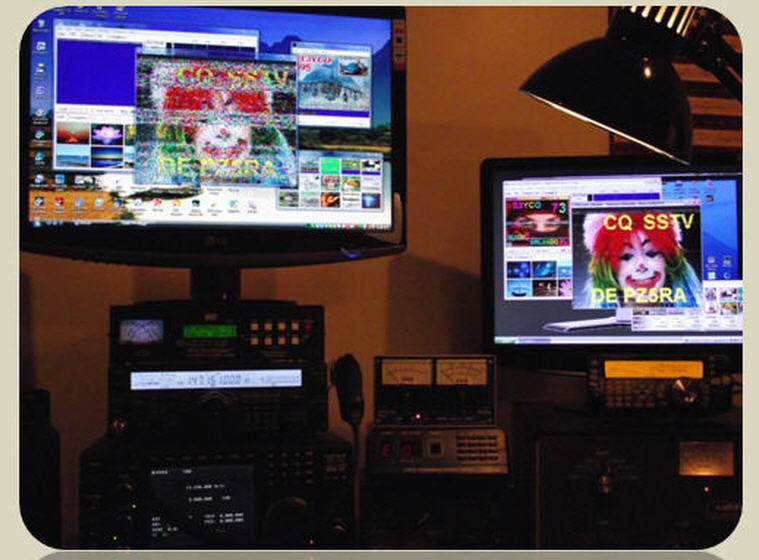
Each radio has it's own dedicated computer.
All are average RAM and ROM, between 1.66 and 3.00. Two computers run Microsoft windows XP Home and three use Vista 32 Home. (They were acquired second-hand from a business and data on the hard drive was erased.) Each laptop interfaces soothly with it's respective radio, providing on-the-fly CAT and PTT control, from it's own respective radio control program.
Each laptop computer runs separate radio control programs
including Ham Radio Deluxe, Pegasus Plus, MMSSTV, (and UISS Packet/AWGPE for the Satellite radio computer), etc. for it's interfaced radio.
Each radio can be controlled from it's own computer screen at a glance
. Each monitor displays the pre-configured and dedicated software used only by that independent computer-radio 'station.'
One mouse and keyboard controls all 5 radio computer screens using
Separate external Sound Cards - Computer Interfaces are used for each radio.
There are three Signalink USB’s, one Ten Tec USB soundcard designed for the Omni-7, and a virtual (VAC) soundcard for the Flex 3000 SDR.
Individual sound card interfaces can be adjusted quickly and easily
and provide a stable, independent sound card source for each radio's software.
Abstract
"It is customary for HF radio transmissions to be sent in a mostly horizontal or vertically polarized fashion, but due to refraction angles, interference, and other ionizing layer effects during propagation, the signal may become distorted or differently polarized at distant reception sites."
"Weak signals often succumb to fade, or cannot be copied clearly.
One way to partially compensate for this problem is to compare reception with separate radios connected to antennas of different polarity or design... ."
The concept has been recently revisited and defined in an excellent article by Joel Hallas, W1ZR, and appears in the May 2011 QST Magazine column “The Doctor is In.” He answers a question about ‘dual diversity reception for weak signal work.’
Joel states: “Diversity reception has been around since before WW2, so it does not require fancy new equipment. The basic idea of HF diversity is that as the ionospheric geometry changes with time, the arrival angle and polarization of incoming signals will change. With a single antenna and receiver, this generally results in the fading that we all have observed. By having two antennas – perhaps one vertical and one horizontal, or at two different heights, or in two locations – the chances are that while one experiences a fade, the other will not. So the first requirement is for two independent antennas and feeds. The two antennas need to be connected to separate receivers so each can operate independently.” (1.) The rest of the article explores the concepts and implementations in greater depth.
Two HF antennas are Horizontally polarized and two are vertically polarized.
- The Cushcraft MA5-B is a 3-element rotatable beam, and the MFJ-1775
is a multiband rotatable dipole.
The Cushcraft MA5-V and Gap Eagle are verticals.
Antennas can be re-assigned to different radios when necessary.
A Comet GP-6 is used for VHF and UHF work.
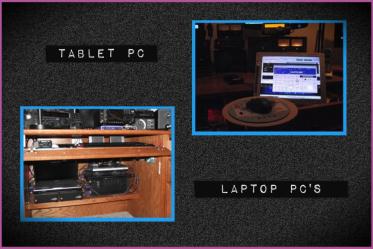
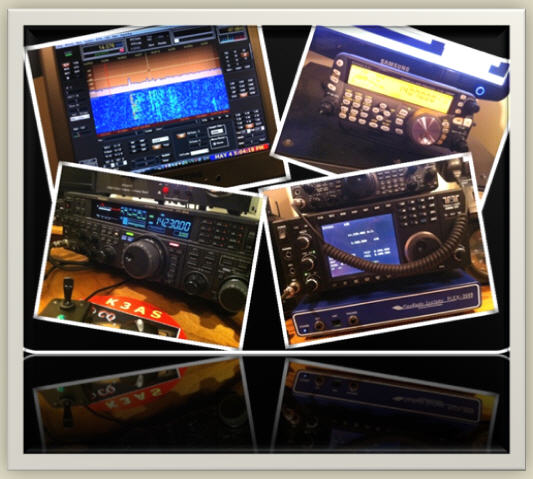
My station is set up to monitor/operate four different modes
on the 40-10 meter bands at the same time. Favorite HF modes include SSTV, drm SSTV, PSK, JT-65A, SSB, and CW. A Yaesu FT-847 is used for 2 meter packet and satellite SSTV.
Each HF transciever is connected to a separate (dedicated) HF antenna, computer, and sound card interface -
And each radio can be tuned and operated independently.
Different digital mode activities can be followed on separate screens at a glance.
For example, I can receive SSTV images from a 20 m QSO using one radio, co-copy or monitor those transmissions with a second, watch 20 m Digital (drm) SSTV images on the third,
and look for 15 m JT-65 DX with the fourth.
*****
Click
On occasion, I use "dual diversity reception" to improve copy of weak signals (see below).
With multiple antennas, I can compare received signals from two radios connected to antennas of opposite polarity (horizontal vs. vertical).
Copy of weak or fading HF signals may be better using one radio
connected to a vertically polarized antenna (my GAP or MA5-V) in comparison to another connected to a horizontal or rotatable antenna (my MA5-B beam or horizontal dipole), despite differences in antenna gains, receiver sensitivities, dsp, use of rx filters, etc.
Dual diversity reception is one more technique that I can use
to successfully copy weak digital mode, ssb, and cw signals.
4 HF Station transceivers (clockwise from top left): Flex-Radio 3000 SDR, Kenwood TS-2000,
Yaesu FT-950, and Ten Tec Omni-7. All can be used for HF Digital modes, SSB, and CW. The fifth radio, a Yaesu FT-847 (not pictured), is used for VHF FM and Satellite work.
Example of how Dual Diversity can help reception: An SSTV image from PZ5RA (Suriname, SA) on 14.230 was copied more clearly using my MA5-V vertical (of lesser gain) on the right vs. the MA5-B beam (directed South) on the left. When antennas were switched between the radios, and beam directivity was further adjusted, the results were the same. Comparisons have ruled out receiver sensitivity, long path, or transmission line issues. Some signals may copy better from my location with an antenna of one polarity vs. the other.
 | ||||||
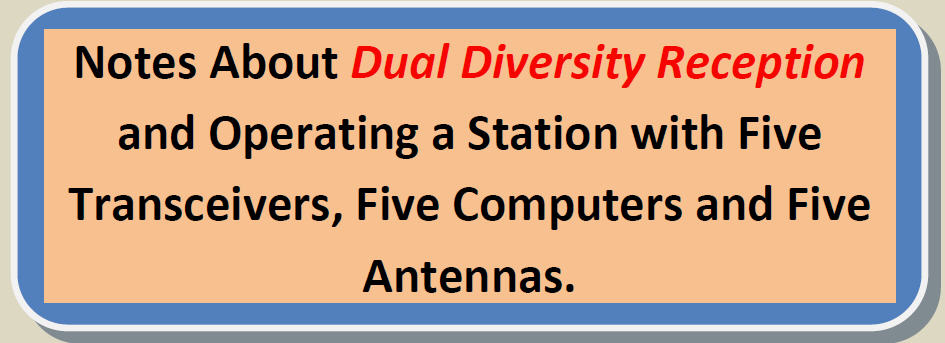
(1). Joel R. Hallas, QST Technical Editor, “The Doctor is In” page 55, QST Magazine, May 2011.
 | ||||||
Each Transceiver operates independently
> Mouseover on Image
> Mouseover the Image
Antennas
Computers
"Synergy" is a free download program that allows a master computer's mouse and keyboard to function as 'server,' linking other computers in an interactive network.
Sound cards / Interfaces
